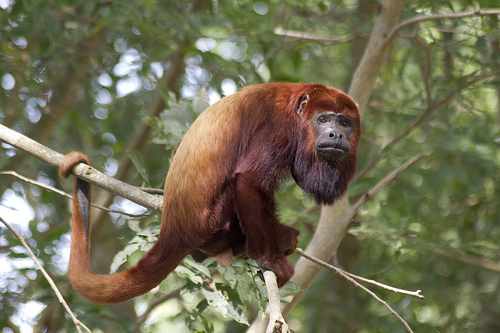
Red howler, orColombian red howler monkey(Alouatta seniculus)
Phylum —chordata
Class — mammalia
Order — primates
Family — atelidae
Genus –alouatta
Appearance
Sexual dimorphism in this species is small; males range from 49–72 cm and females from 46–57 cm long. The males weigh 5.4-9 kg, while females weigh 4.2–7 kg. It has a long prehensile tail of 49–75 cm.
The tail is covered with fur except for the last third of the underside, which allows it to grab branches. The color of both males and females is a deep reddish-brown, and the color shade changes with age. Their faces are surrounded by fur and they have stubby noses.
Habitat
Red howler monkeys live throughout northwestern South America, in Bolivia, Brazil, Colombia, Ecuador, Guyana, French Guiana, Venezuela, Peru, Suriname, the island of Trinidad and other South American countries.
Behavior
Red howlers form groups of between 1 to 3 males with 2 to 7 females and different numbers of juveniles. Males in bachelor groups from time to time try to gain the control of a group with females by fighting the lead male. Males wake up the forest early in the morning by howling loudly, being audible as far as 2 miles (5 km) distant. They also howl at night before sleeping, being answered by males in other red howler groups, letting them know where they are so that there is no overlapping of territories. Red howlers are most active during the morning, when groups move about looking for a feeding spot. They dislike rain, and howl when it is raining, sitting hunched over in trees. They usually stay high up in trees in order to find the most leaves.
Diet
Red howler monkeys eat flowers, leaves and fruit, leaves being up to 60% of their consumption. Howlers are selective eaters, avoiding leaves that are poisonous or unsafe. They favor young tender leaves, being easier to digest and having more protein and sugar.
Reproduction
Red howler monkeys are polygynous, one male mating with multiple females. The female usually invites courtship by sticking out her tongue at a male. If there is no response, she approaches another male. Mating takes place throughout the year, gestation is for 6 months and one baby is born. At one month, infants are able to use their tail to cling on to their mother, riding on her back, until they are one year old. Nursing lasts until the young are between 18 and 24 months old. Males can be very affectionate with the infants, though only with their direct offspring. Males are sexually mature after 5 years and females at 4 years old.
They can live to be over 20 years old.
In captivity
When choosing a home for your monkey, keep in mind that it has a very prehensile and strong tail. Most of the time these animals spend in trees, so the cage must be equipped accordingly. Make sure that the material from which you plan to build an aviary is durable, natural and non-toxic.
Howlers are native to tropical forests, so they need to provide a similar climate. The ideal temperature should be between 26 and 32 degrees Celsius. And should not fall below 23. Cold weather and drafts can cause respiratory diseases that can be fatal if they are not treated in time.
Perhaps the most difficult thing for howler owners is to find a qualified veterinarian. First, ask the person who sold the monkey to you about it, because sellers who value their reputation always have connections with a good veterinarian. If there are none in your region, conduct an independent "investigation" and ask around. A veterinarian should understand exotic animals. Not everyone knows how and what medications to give them.
It is very important to feed the howler correctly. 90% of its diet in captivity consists of fruits and nuts. You should also give the monkey sprouted grains (rice, peas, wheat, barley). Now there are also commercial feeds on sale, such as feed for new world primates. Commercial feed is good, but the main food source should be fruits and nuts.
If you have other pets in the house, do not leave them to play without supervision. Pets are very territorial and may try to survive the monkey. Spider monkeys are very curious creatures, and if you don't watch them, they can cause a lot of trouble.
 Russian
Russian
 English
English























